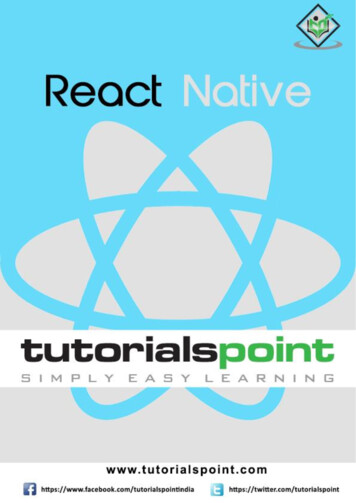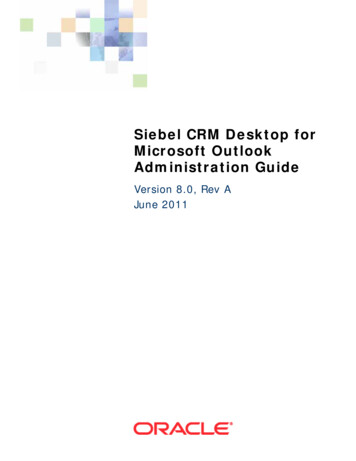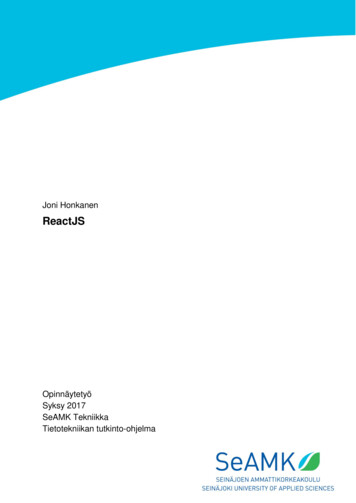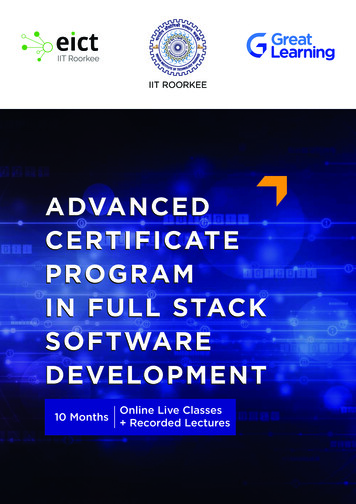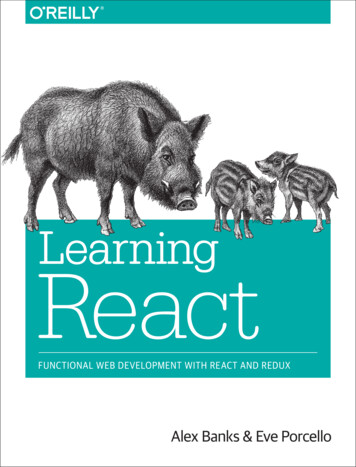
Transcription
LearningReactFUNCTIONAL WEB DEVELOPMENT WITH REACT AND REDUXAlex Banks & Eve Porcello
Learning ReactIf you want to learn how to build efficient user interfaces with React, this isyour book. Authors Alex Banks and Eve Porcello show you how to createUIs with this small JavaScript library that can deftly display data changeson large-scale, data-driven websites without page reloads. Along theway, you’ll learn how to work with functional programming and the latestECMAScript features.Developed by Facebook, and used by companies including Netflix,Walmart, and The New York Times for large parts of their web interfaces,React is quickly growing in use. By learning how to build React componentswith this hands-on guide, you’ll fully understand how useful React can bein your organization. Learn key functional programming concepts with JavaScript Peek under the hood to understand how React runs in the browser Create application presentation layers by mounting andcomposing React components Use component trees to manage data and reduce the time youspend debugging applications Explore React’s component lifecycle and use it to load data andimprove UI performance Use a routing solution for browser history, bookmarks, andother features of single-page applications Learn how to structure React applications with servers in mindReact takes the“Learningfunctional programmingideas behind React andmakes them accessible,and immediately usefulfor anyone who wants tobuild modern JavaScriptapplications. It's a greatguide to the commonchallenges and solutionsassociated with Reactapplications.”—Bonnie EisenmanSoftware Engineer, Twitter andauthor of Learning React NativeAlex Banks is a software engineer, instructor, and cofounder of Moon Highway,a curriculum development company in California. He’s developed applications forthe Chicago Marathon, MSN, and the Department of Energy.Eve Porcello is a software architect, trainer, and cofounder of Moon Highway.She also has taught JavaScript and Python at Stanford University, PayPal, eBay,and Lynda.com.JAVA SCRIPTUS 49.99Twitter: @oreillymediafacebook.com/oreillyCAN 65.99ISBN: 978-1-491-95462-1
Learning ReactFunctional Web Developmentwith React and ReduxAlex Banks and Eve PorcelloBeijingBoston Farnham SebastopolTokyo
Learning Reactby Alex Banks and Eve PorcelloCopyright 2017 Alex Banks and Eve Porcello. All rights reserved.Printed in the United States of America.Published by O’Reilly Media, Inc., 1005 Gravenstein Highway North, Sebastopol, CA 95472.O’Reilly books may be purchased for educational, business, or sales promotional use. Online editions arealso available for most titles (http://oreilly.com/safari). For more information, contact our corporate/insti‐tutional sales department: 800-998-9938 or corporate@oreilly.com.Editor: Allyson MacDonaldProduction Editor: Melanie YarbroughCopyeditor: Colleen ToporekProofreader: Rachel HeadMay 2017:Indexer: WordCo Indexing ServicesInterior Designer: David FutatoCover Designer: Karen MontgomeryIllustrator: Rebecca DemarestFirst EditionRevision History for the First Edition2017-04-26: First Release2018-02-09: Second ReleaseSee http://oreilly.com/catalog/errata.csp?isbn 9781491954621 for release details.The O’Reilly logo is a registered trademark of O’Reilly Media, Inc. Learning React, the cover image, andrelated trade dress are trademarks of O’Reilly Media, Inc.While the publisher and the authors have used good faith efforts to ensure that the information andinstructions contained in this work are accurate, the publisher and the authors disclaim all responsibilityfor errors or omissions, including without limitation responsibility for damages resulting from the use ofor reliance on this work. Use of the information and instructions contained in this work is at your ownrisk. If any code samples or other technology this work contains or describes is subject to open sourcelicenses or the intellectual property rights of others, it is your responsibility to ensure that your usethereof complies with such licenses and/or rights.978-1-491-95462-1[LSI]
Table of ContentsPreface. . . . . . . . . . . . . . . . . . . . . . . . . . . . . . . . . . . . . . . . . . . . . . . . . . . . . . . . . . . . . . . . . . . . . . . ix1. Welcome to React. . . . . . . . . . . . . . . . . . . . . . . . . . . . . . . . . . . . . . . . . . . . . . . . . . . . . . . . . . . 1Obstacles and RoadblocksReact Is a LibraryNew ECMAScript SyntaxPopularity of Functional JavaScriptJavaScript Tooling FatigueWhy React Doesn’t Have to Be Hard to LearnReact’s FutureKeeping Up with the ChangesWorking with the FilesFile RepositoryReact Developer ToolsInstalling Node.js1222233444562. Emerging JavaScript. . . . . . . . . . . . . . . . . . . . . . . . . . . . . . . . . . . . . . . . . . . . . . . . . . . . . . . . . 9Declaring Variables in ES6constletTemplate StringsDefault ParametersArrow FunctionsTranspiling ES6ES6 Objects and ArraysDestructuring AssignmentObject Literal EnhancementThe Spread Operator1010101213141719192022iii
PromisesClassesES6 ModulesCommonJS242527283. Functional Programming with JavaScript. . . . . . . . . . . . . . . . . . . . . . . . . . . . . . . . . . . . . . 31What It Means to Be FunctionalImperative Versus DeclarativeFunctional ConceptsImmutabilityPure FunctionsData TransformationsHigher-Order FunctionsRecursionCompositionPutting It All Together323436363841484952534. Pure React. . . . . . . . . . . . . . . . . . . . . . . . . . . . . . . . . . . . . . . . . . . . . . . . . . . . . . . . . . . . . . . . . 59Page SetupThe Virtual DOMReact ElementsReactDOMChildrenConstructing Elements with DataReact ComponentscreateClassES6 ClassesStateless Functional ComponentsDOM RenderingFactories5960626465676869727374775. React with JSX. . . . . . . . . . . . . . . . . . . . . . . . . . . . . . . . . . . . . . . . . . . . . . . . . . . . . . . . . . . . . 81React Elements as JSXJSX TipsBabelRecipes as JSXIntro to WebpackWebpack LoadersRecipes App with a Webpack Build818284859394946. Props, State, and the Component Tree. . . . . . . . . . . . . . . . . . . . . . . . . . . . . . . . . . . . . . . . 109Property Validationiv Table of Contents109
Validating Props with createClassDefault PropsCustom Property ValidationES6 Classes and Stateless Functional ComponentsRefsInverse Data FlowRefs in Stateless Functional ComponentsReact State ManagementIntroducing Component StateInitializing State from PropertiesState Within the Component TreeColor Organizer App OverviewPassing Properties Down the Component TreePassing Data Back Up the Component Tree1101141151161191211231231241281301301311347. Enhancing Components. . . . . . . . . . . . . . . . . . . . . . . . . . . . . . . . . . . . . . . . . . . . . . . . . . . . 141Component LifecyclesMounting LifecycleUpdating LifecycleReact.ChildrenJavaScript Library IntegrationMaking Requests with FetchIncorporating a D3 TimelineHigher-Order ComponentsManaging State Outside of ReactRendering a ClockFluxViewsActions and Action CreatorsDispatcherStoresPutting It All TogetherFlux 61771781781791808. Redux. . . . . . . . . . . . . . . . . . . . . . . . . . . . . . . . . . . . . . . . . . . . . . . . . . . . . . . . . . . . . . . . . . . 183StateActionsAction Payload DataReducersThe Color ReducerThe Colors ReducerThe Sort Reducer184187189190193195197Table of Contents v
The StoreSubscribing to StoresSaving to localStorageAction CreatorsMiddlewareApplying Middleware to the Store1982012022032062079. React Redux. . . . . . . . . . . . . . . . . . . . . . . . . . . . . . . . . . . . . . . . . . . . . . . . . . . . . . . . . . . . . . 211Explicitly Passing the StorePassing the Store via ContextPresentational Versus Container ComponentsThe React Redux ProviderReact Redux connect21321622022322410. Testing. . . . . . . . . . . . . . . . . . . . . . . . . . . . . . . . . . . . . . . . . . . . . . . . . . . . . . . . . . . . . . . . . . 229ESLintTesting ReduxTest-Driven DevelopmentTesting ReducersTesting the StoreTesting React ComponentsSetting Up the Jest EnvironmentEnzymeMocking ComponentsSnapshot TestingUsing Code Coverage22923323323424224524524724925826211. React Router. . . . . . . . . . . . . . . . . . . . . . . . . . . . . . . . . . . . . . . . . . . . . . . . . . . . . . . . . . . . . . 273Incorporating the RouterRouter PropertiesNesting RoutesUsing a Page TemplateSubsections and SubmenusRouter ParametersAdding Color Details PageMoving Color Sort State to Router27427727927928128628629212. React and the Server. . . . . . . . . . . . . . . . . . . . . . . . . . . . . . . . . . . . . . . . . . . . . . . . . . . . . . . 297Isomorphism versus UniversalismServer Rendering ReactUniversal Color OrganizerUniversal Reduxvi Table of Contents297301306308
Universal RoutingCommunicating with the ServerCompleting Actions on the ServerActions with Redux Thunks310318318321Index. . . . . . . . . . . . . . . . . . . . . . . . . . . . . . . . . . . . . . . . . . . . . . . . . . . . . . . . . . . . . . . . . . . . . . . 329Table of Contents vii
PrefaceThis book is for developers who want to learn the React library while learning thelatest techniques currently emerging in the JavaScript language. This is an excitingtime to be a JavaScript developer. The ecosystem is exploding with new tools, syntax,and best practices that promise to solve many of our development problems. Our aimwith this book is to organize these techniques, so you can get to work with React rightaway. We’ll get into Redux, React Router, and build tooling, so we promise not tointroduce only the basics and then throw you to the wolves.This book does not assume any knowledge of React at all. We’ll introduce all ofReact’s basics from scratch. Similarly, we won’t assume that you’ve worked with ES6or any of the latest JavaScript syntax. This will be introduced in Chapter 2 as founda‐tion for the rest of the chapters.You’ll be better prepared for the contents of the book if you’re comfortable withHTML, CSS, and JavaScript. It’s almost always best to be comfortable with these bigthree before diving into a JavaScript library.Along the way, check out the GitHub repository. All of the examples are there andwill allow you to practice with hands-on examples.Conventions Used in This BookThe following typographical conventions are used in this book:ItalicIndicates new terms, URLs, email addresses, filenames, and file extensions.Constant widthUsed for program listings, as well as within paragraphs to refer to program ele‐ments such as variable or function names, databases, data types, environmentvariables, statements, and keywords.ix
Constant width boldShows commands or other text that should be typed literally by the user.Constant width italicShows text that should be replaced with user-supplied values or by values deter‐mined by context.This element signifies a tip or suggestion.This element signifies a general note.This element indicates a warning or caution.Using Code ExamplesSupplemental material (code examples, exercises, etc.) is available for download is book is here to help you get your job done. In general, if example code is offeredwith this book, you may use it in your programs and documentation. You do notneed to contact us for permission unless you’re reproducing a significant portion ofthe code. For example, writing a program that uses several chunks of code from thisbook does not require permission. Selling or distributing a CD-ROM of examplesfrom O’Reilly books does require permission. Answering a question by citing thisbook and quoting example code does not require permission. Incorporating a signifi‐cant amount of example code from this book into your product’s documentation doesrequire permission.We appreciate, but do not require, attribution. An attribution usually includes thetitle, author, publisher, and ISBN. For example: “Learning React by Alex Banks andEve Porcello (O’Reilly). Copyright 2017 Alex Banks, Eve Porcello,978-1-491-95462-1.”x Preface
If you feel your use of code examples falls outside fair use or the permission givenabove, feel free to contact us at permissions@oreilly.com.O’Reilly SafariSafari (formerly Safari Books Online) is a membership-basedtraining and reference platform for enterprise, government,educators, and individuals.Members have access to thousands of books, training videos, Learning Paths, interac‐tive tutorials, and curated playlists from over 250 publishers, including O’ReillyMedia, Harvard Business Review, Prentice Hall Professional, Addison-Wesley Profes‐sional, Microsoft Press, Sams, Que, Peachpit Press, Adobe, Focal Press, Cisco Press,John Wiley & Sons, Syngress, Morgan Kaufmann, IBM Redbooks, Packt, AdobePress, FT Press, Apress, Manning, New Riders, McGraw-Hill, Jones & Bartlett, andCourse Technology, among others.For more information, please visit http://oreilly.com/safari.How to Contact UsPlease address comments and questions concerning this book to the publisher:O’Reilly Media, Inc.1005 Gravenstein Highway NorthSebastopol, CA 95472800-998-9938 (in the United States or Canada)707-829-0515 (international or local)707-829-0104 (fax)We have a web page for this book, where we list errata, examples, and any additionalinformation. You can access this page at http://bit.ly/learning-react-2e.To comment or ask technical questions about this book, send email to bookques‐tions@oreilly.com.For more information about our books, courses, conferences, and news, see our web‐site at http://www.oreilly.com.Find us on Facebook: http://facebook.com/oreillyFollow us on Twitter: http://twitter.com/oreillymediaWatch us on YouTube: http://www.youtube.com/oreillymediaPreface xi
AcknowledgmentsOur journey with React wouldn’t have started without some good old fashioned luck.We used YUI when we created the training materials for the full stack JavaScript pro‐gram that we taught internally at Yahoo. Then in August 2014, development on YUIended. We had to change all of our course files, but to what? What were we supposedto use on the front end now? The answer: React. We didn’t fall in love with Reactimmediately, it took us couple of hours to get hooked. It looked like React couldpotentially change everything. We got in early and got really lucky.This book would not have been possible without the support of Ally MacDonald whohelped us every step of the way and was monumentally patient with us through sev‐eral library updates. We’re grateful to Melanie Yarbrough, Colleen Toporek, andRachel Head for their amazing attention to detail. Thanks to Sarah Ronau for proof‐reading this book well before it was ready for human eyes and to Bonnie Eisenmanfor her great advice and overall delightfulness. Thanks also to Stoyan Stefanov, whowas nice enough to provide a technical review even though he’s really busy buildingcool stuff at Facebook.There’s also no way this book could have existed without the Sharon Adams andMarilyn Messineo. They conspired to purchase Alex’s first computer, a Tandy TRS 80Color Computer. It also wouldn’t have made it to book form without the love, sup‐port, and encouragement of Jim and Lorri Porcello, and Mike and Sharon Adams.We’d also like to acknowledge Coffee Connexion in Tahoe City, California for givingus the coffee we needed to finish this book, and its owner, Robin, who gave us thetimeless advice: “A book on programming? Sounds boring!”xii Preface
CHAPTER 1Welcome to ReactReact is a popular library used to create user interfaces. It was built at Facebook toaddress some of the challenges associated with large-scale, data-driven websites.When React was released in 2013, the project was initially viewed with some skepti‐cism because the conventions of React are quite unique.In an attempt to not intimidate new users, the core React team wrote an article called“Why React?” that recommended that you “Give It [React] Five Minutes.” Theywanted to encourage people to work with React first before thinking that theirapproach was too crazy.Yes, React is a small library that doesn’t come with everything you might need out ofthe box to build your application. Give it five minutes.Yes, in React, you write code that looks like HTML right in your JavaScript. And yes,those tags require preprocessing to run in a browser. And you’ll probably need abuild tool like webpack for that. Give it five minutes.If you read that article—as we did—you may have been dazzled by the promise of anew JavaScript library—a library that would solve all of our problems with the DOM;a library that would always be easy to work with and would never hurt us.Then the questions start to arise: how do I convert this JSX? How do I load data?Where does the CSS go? What is declarative programming? Every path leads to morequestions about how to incorporate this library in your actual day to day work. Everyconversation introduces new terminology, new techniques, and more questions.Obstacles and RoadblocksBy taking a few minutes to learn about React components, you’ve opened a door to adifferent way of thinking about and approaching web development. However, there1
are some learning obstacles that you’ll have to overcome to begin writing productioncode with React.React Is a LibraryFirst, the React library is small and it is only used for one part of the job. It doesn’tship with all of the tools that you’d expect from a traditional JavaScript framework. Alot of the decisions about which tools from the ecosystem to use are left up to thedeveloper. Also, new tools emerge all the time, and old ones are cast aside. There areso many different library names continually being added to the discussion that it mayfeel like it’s impossible to keep up.New ECMAScript SyntaxReact has come of age in an important but chaotic time in the history of JavaScript.The ECMA used to release specifications infrequently. It would sometimes take up to10 years to release a spec. This meant that developers wouldn’t need to learn new syn‐tax very often.As of 2015, new language features and syntax additions will be released every year.This replaces a numbered release system (ECMAScript3, ECMAScript 5) with ayearly one (ECMAScript 2016, ECMAScript 2017). As the language evolves, the earlyadopters in the React community tend to use the new syntax. This often means thatdocumentation assumes knowledge of the latest ECMAScript syntax. If you are notfamiliar with the latest spec, looking at React code can be daunting.Popularity of Functional JavaScriptIn addition to the changes emerging at a language level, there is a lot of momentumaround functional JavaScript programming. JavaScript isn’t necessarily a functionallanguage, but functional techniques can be used in JavaScript code. React emphasizesfunctional programming over object-oriented programming. This shift in thinkingcan lead to benefits in areas like testability and performance. But when a lot of Reactmaterials assume an understanding of the paradigm, it can be hard to learn so muchat once.JavaScript Tooling FatigueIt’s a cliche at this point to talk about JavaScript Fatigue, but the source of this fakeillness can be traced back to the building process. In the past, you just added Java‐Script files to your page. Now the JavaScript file has to be built, usually with an auto‐mated continuous delivery process. There’s emerging syntax that has to be transpiledto work in all browsers. There’s JSX that has to be converted to JavaScript. There’sSCSS that you might want to preprocess. These components need to be tested, and2 Chapter 1: Welcome to React
they have to pass. You might love React, but now you also need to be a webpackexpert, handling code splitting, compression, testing, and on and on.Why React Doesn’t Have to Be Hard to LearnThe goal of this book is to avoid confusion in the learning process by putting thingsin sequence and building a strong learning foundation. We’ll start with a syntaxupgrade to get you acquainted with the latest JavaScript features, especially the onesthat are frequently used with React. Then we’ll give an introduction to functionalJavaScript so you can apply these techniques immediately and understand the para‐digm that gave birth to React.From there, we will cover foundational React knowledge including your first compo‐nents and how and why we need to transpile our code. With the basics in place, wewill break ground on a new application that allows users to save and organize colors.We will build this application using React, improve the code with advanced Reacttechniques, introduce Redux as the client data container, and finish off the app byincorporating Jest testing and routing with the React Router. In the final chapter, wewill introduce universal and isomorphic code and enhance the color organizer byrendering it on the server.We hope to get you up to speed with the React ecosystem faster by approaching it thisway—not just to scratch the surface, but to equip you with the tools and skills neces‐sary to build real world React applications.React’s FutureReact is still new. It has reached a place where core functionality is fairly stable, buteven that can change. Future versions of React will include Fiber, a reimplementationof React’s core algorithm which is aimed at increasing rendering speed. It’s a littleearly to hypothesize about how this will affect React developers, but it will definitelyaffect the speed at which apps are rendered and updated.Many of these changes have to do with the devices that are being targeted. This bookcovers techniques for developing single-page web applications with React, but weshouldn’t assume that web browsers are the only place that React apps can run. ReactNative, released in 2015, allows you to take the benefits of React applications into iOSand Android native apps. It’s still early, but React VR, a framework for building inter‐active, virtual reality apps, has emerged as a way to design 360 degree experiencesusing React and JavaScript. A command of the React library will set you up to rapidlydevelop experiences for a range of screen sizes and types.We hope to provide you with a strong enough foundation to be able to adapt to thechanging ecosystem and build applications that can run on platforms beyond the webbrowser.React’s Future 3
Keeping Up with the ChangesAs changes are made to React and related tools, sometimes there are breakingchanges. In fact, some of the future versions of these tools may break some of theexample code in this book. You can still follow along with the code samples. We’llprovide exact version information in the package.json file, so that you can install thesepackages at the correct version.Beyond this book, you can stay on top of changes by following along with the officialReact blog. When new versions of React are released, the core team will write adetailed blog post and changelog about what is new.There are also a variety of popular React conferences that you can attend for the latestReact information. If you can’t attend these in person, React conferences often releasethe talks on YouTube following the events. These include:React ConfFacebook-sponsored conference in the Bay AreaReact RallyCommunity conference in Salt Lake CityReactiveConfCommunity conference in Bratislava, SlovakiaReact AmsterdamCommunity conference in AmsterdamWorking with the FilesIn this section, we will discuss how to work with the files for this book and how toinstall some useful React tools.File RepositoryThe GitHub repository associated with this book provides all of the code files organ‐ized by chapter. The repository is a mix of code files and JSBin samples. If you’venever used JSBin before, it’s an online code editor similar to CodePen and JSFiddle.One of the main benefits of JSBin is that you can click the link and immediately starttinkering with the file. When you create or start editing a JSBin, it will generate aunique URL for your code sample, as in Figure 1-1.4 Chapter 1: Welcome to React
Figure 1-1. JSBin URLThe letters that follow jsbin.com represent the unique URL key. After the next slash isthe version number. In the last part of the URL, there will be one of two words: editfor editing mode or quiet for preview mode.React Developer ToolsThere are several developer tools that can be installed as browser extensions or addons that you may find useful as well:react-detectorreact-detector is a Chrome extension that lets you know which websites are usingReact and which are not.show-me-the-reactThis is another tool, available for Firefox and Chrome, that detects React as youbrowse the internet.React Developer Tools (see Figure 1-2)This is a plugin that can extend the functionality of the browser’s developer tools.It creates a new tab in the developer tools where you can view React elements.If you prefer Chrome, you can install it as an extension; you can also install it asan add-on for Firefox.Working with the Files 5
Figure 1-2. Viewing the React Developer ToolsAny time you see react-detector or show-me-the-react as active, you can open thedeveloper tools and get an understanding of how React is being used on the site.Installing Node.jsNode.js is JavaScript without the browser. It is a runtime environment used to buildfull-stack JavaScript applications. Node is open source and can be installed on Win‐dows, macOS, Linux, and other platforms. We will be using Node in Chapter 12 whenwe build an Express server.You do not need to use Node to use React. However, when working with React, youneed to use the Node package manager, npm, to install dependencies. This is auto‐matically installed with the Node installation.If you’re not sure if Node.js is installed on your machine, you can open a Terminal orCommand Prompt window and type: node -vOutput: v7.3.0Ideally, you will have a Node version number of 4 or higher. If you type the commandand see an error message that says “Command not found,” Node.js is not installed.This can be done directly from the Node.js website. Just go through the automatedsteps of the installer, and when you type in the node -v command again, you’ll seethe version number.6 Chapter 1: Welcome to React
Dependency Management with YarnAn optional alternative for npm is Yarn. It was released in 2016 by Facebook, in col‐laboration with Exponent, Google, and Tilde. The project helps Facebook and othercompanies manage their dependencies more reliably, and when using it to installpackages, you’ll likely notice that it’s much faster. You can compare npm and Yarn’sperformance at the Yarn website.If you’re familiar with the npm workflow, getting up to speed with Yarn is fairly sim‐ple. First, install Yarn globally with npm.npm install -g yarnThen, you are ready to install packages. When installing dependencies from the pack‐age.json, in place of npm install, you can run yarn.When installing specific packages, Instead of running npm install --save[package-name], run:yarn add [package-name]To remove a dependency, the command is familiar too:yarn remove [package-name]Yarn is used in production by Facebook and is included in projects like React, ReactNative, and create-react-app. If you ever find a project that contains a yarn.lock file,the project uses yarn. Similar to the npm install command, you can install all of thedependencies of the project by typing yarn install or simply yarn.Now that you have your environment set up for React development, we are ready tobegin overcoming learning obstacles. In Chapter 2, we will address ECMA, and getup to speed with the latest JavaScript syntax that is most commonly found in Reactcode.Working with the Files 7
CHAPTER 2Emerging JavaScriptSince its release in 1995, JavaScript has gone through many changes. At first, it madeadding interactive elements to web pages much simpler. Then it got more robust withDHTML and AJAX. Now, with Node.js, JavaScript has become a language that is usedto build full-stack applications. The committee that is and has been in charge of shep‐herding the changes to JavaScript is the European Computer Manufacturers Associa‐tion (ECMA).Changes to the language are community-driven. They originate from proposals thatcommunity members write. Anyone can submit a proposal to the ECMA committee.The responsibility of the ECMA committee is to manage and prioritize these propos‐als in order to decide what is included in each spec. Proposals are taken throughclearly defined stages, from stage 0, which represents the newest proposals, upthrough stage 4, which represents the finished proposals.The most recent major update to the specification was approved in June 20151 and iscalled by many names: ECMAScript 6, ES6, ES2015, and ES6Harmony. Based on cur‐rent plans, new specs will be released on a yearly cycle. The 2016 release was relativelysmall, but it already looks like ES2017 will include quite a few useful features. We’ll beusing many of these new features in the book and will opt to use emerging JavaScriptwhenever possible.Many of these features are already supported by the newest browsers. We will also becovering how to convert your code from emerging JavaScript syntax to ES5 syntaxthat will work today in almost all browsers. The kangax compatibility table is a greatplace to stay informed about the latest JavaScript features and their varying degrees ofsupport by browsers.1 Abel Avram, “ECMAScript 2015 Has Been Approved”, InfoQ, June 17, 2015.9
In this chapter, we will show you all of the emerging JavaScript that we’ll be usingthroughout the book. If you haven’t made the switch to the latest syntax yet, nowwould be a good time to get started. If you are already comfortable with ES.Next lan‐guage features, skip to the next chapter.Declaring Variables in ES6Prior to ES6, the only way to declare a variable was with the var keyword. We nowhave a few different options that provide improved functionality
Learning React ISBN: 978-1-491-95462-1 US 49.99 CAN 65.99 " Learning React akeshet t functionalrogramming p ideasehind b React and makeshem t accessible, andmmediately i useful fornyone a who wants to builddern mo JavaScript applications. It's a great guideohe t t common challenges and solutions associated with React applications."

